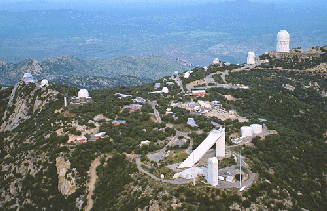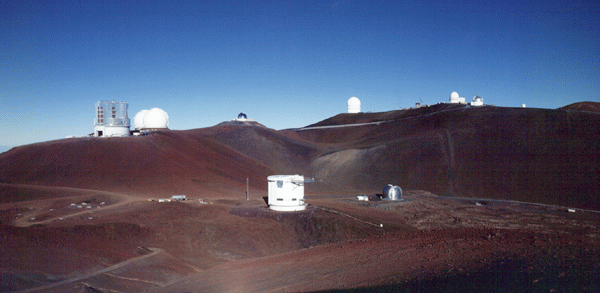Video lecture for this chapter
This material (including images) is copyrighted!.
See my copyright notice for fair use
practices. Select the photographs to display the original source in
another window.
Many people believe that astronomers want to build telescopes on tall
mountains or
put them in space, so they can be ``closer'' to the objects they are
observing.
This is INcorrect! The
nearest star is over 41,500,000,000,000 kilometers (26 trillion miles)
away.
If you ignore the 300-million kilometer variation in the distances due to the
Earth's motion
around the Sun and the 12,756-kilometer variation due to the Earth's
rotation, being 4
kilometers closer on a tall mountain amounts to a difference of at most
1 × 10-11
percent. Telescopes in space get up to 1 × 10-9
percent closer
(again ignoring the much larger variations of the Earth's orbit around the
Sun and the
telescope's orbit around the Earth). These are extremely small
differences---the
distances to the even the nearest stars are around 100,000's times greater
than
the distances between the planets in our solar system. The reason
large telescopes are built on tall mountains or put in space is to get
away from the
distortion of starlight due to the atmosphere. The atmospheric
distortion is poor seeing, reddening, extinction and the adding of
absorption lines to stellar spectra.
 The famous observing site
at the Kitt Peak
National
Observatory has many large telescopes including the 4-meter
Mayall
telescope(top right) and the McMath
Solar Telescope (triangular one at the lower
right).
Although it is over 60 kilometers from Tucson, AZ, light pollution from
the increasing
population of that city has stopped the construction of any more
telescopes on the
mountain.
The famous observing site
at the Kitt Peak
National
Observatory has many large telescopes including the 4-meter
Mayall
telescope(top right) and the McMath
Solar Telescope (triangular one at the lower
right).
Although it is over 60 kilometers from Tucson, AZ, light pollution from
the increasing
population of that city has stopped the construction of any more
telescopes on the
mountain.
The Mauna Kea Observatory is
probably
the best observing site in the world. Many very large telescopes are at the
4177-meter summit of the extinct volcano. Because of the elevation, the
telescopes
are above most of the water vapor in the atmosphere, so near-infrared astronomy
can be
done (near-infrared is the part of the infrared band that is nearest the visible light band, so it is slightly longer wavelengths than red). Kitt Peak's elevation of 2070 meters is too low for infrared
telescopes. Telescopes used for near-infrared astronomy need to be at least 2750 meters elevation to get above enough of the water vapor to make the investment worthwhile.

The James C. Maxwell Telescope is in the center front of this picture of the Mauna Kea
Observatory. The two white Keck
10-meter telescopes are to the left on the
ridgetop next to the silver 8.3-meter Subaru telescope. Select the image to
go to the Mauna Kea Observatory homepage (will display in another window).
 Go back to previous section --
Go back to previous section --
 Go to next section
Go to next section
last updated:
January 20, 2022
Is this page a copy of Strobel's
Astronomy Notes?
Author of original content:
Nick Strobel
 The famous observing site
at the Kitt Peak
National
Observatory has many large telescopes including the 4-meter
Mayall
telescope(top right) and the McMath
Solar Telescope (triangular one at the lower
right).
Although it is over 60 kilometers from Tucson, AZ, light pollution from
the increasing
population of that city has stopped the construction of any more
telescopes on the
mountain.
The famous observing site
at the Kitt Peak
National
Observatory has many large telescopes including the 4-meter
Mayall
telescope(top right) and the McMath
Solar Telescope (triangular one at the lower
right).
Although it is over 60 kilometers from Tucson, AZ, light pollution from
the increasing
population of that city has stopped the construction of any more
telescopes on the
mountain.
